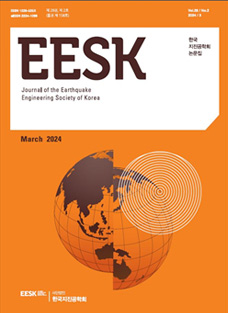1.서 론
Seismic displacements of a foundation-pile system were estimated by a response displacement method and a pseudo 3D finite element numerical method, and their results were compared to verify the reliability of the response displacement method. Seismic design of underground structures can be carried out by response acceleration method, response displacement method or dynamic analysis method. However, displacements of underground structures were calculated practically by a response displacement method, as displacements and deformations in the soil layer are important for the seismic design of underground structures even though inertia forces are important for the design of structures on the ground.
Recently, domestic studies on the dynamic design of structures built on a pile foundation are carried out by some researchers. Han et al.[1] in 2011 studied on the dynamic earth pressure acting on a pile using shaking table tests. Lee and Kim[2] in 2012 studied on the analyzing technique for laterally loaded piles accommodating static p-y curves obtained from experimental tests at a local site, and Jang et al.[3] in 2013 studied on the lateral behavior of a monopile foundation in the sandy soil using stiffness matrix method, p-y curve method, and 2D and 3D soil modeling methods.
And foreign studies on the seismic design of underground structures are also performed by serveral researchers. Song et al.[4] in 2007 studied on the calculation of soil pressure along a pile based on the displacement, and compared study results with those of a p-y curve theory to verify the rationality of them. Takahashi et al.[5] in 2008 performed centrifuge tests to observe effects of a mobilisation of earth pressure acting on pile caps under cyclic loading, and proposed a simple empirical model for the non-linear Winkler type foundation analysis. Kimura et al.[6] in 2000 conducted static and dynamic three-dimensional elasto-plastic finite element analyses to provide a relatively simple numerical method for a full soil-pile-structure system considering the interaction between soils and foundations. Eslami et al.[7] in 2011 compared seismic behaviors (internal momemts, shear forces and deflections) of pile group foundations and piled raft (pile cap) foundations using the 3D finite element modeling.
However, it was hard to find any paper performing a seismic analysis of an embedded mat foundation built on a pile group using a 3D finite element method to estimate seismic soil pressure on the mat foundation and displacements of a pile group.
In this study, seismic pile design by a pseudo 3D finite element method was carried out to compare numerical results with results of the response displacement method considering 3D characteristics of a foundation-soil system which is important for the building foundation analyses. Analyses were performed with a bedrock earthquake downloaded from the PEER database[8] for 3 different underlying soil types of SB, SC and SD[9].
2.Model for Response Displacement Method
Foundation displacements including pile displacements were estimated by a conventional response displacement method, considering the first mode of the dynamic motion of a soil layer[10]. The first mode shape was assumed to be a sinusoidal wave form as shown in Fig. 1.
The lateral force at the foundation level of Zf can be estimated considering a relative displacement of a foundation with respect to the foundation base which is located at the soil depth of ZB. And the lateral force acting on the pile level of Zp can be estimated considering a relative displacement of a pile with respect to the bedrock which is located at the soil depth of H.
The lateral pressure on the foundation wall can be calculated as follows. The relative displacement is(1)
In here, Sa(m/s2) is a design response acceleration of a free surface at the fundamental period of a soil layer(), and Cs is a shear wave velocity of a soil.(2)
In here, horizontal elastic foundation-soil stiffness of Kh and a contact side wall area of a mat foundation(A) can be estimated by following Eq. (3) and (4)[17], however horizontal stiffness is reduced to a half taking into account a mat foundation supported to both left and right sides.
In here, Gs is a dynamic shear modulus of a soil layer which is ρ⋅, and ρ is a soil density and ν is a Poisson’s ratio of a soil.
Also, displacement of a pile can be calculated with the Eq. (5) as follows. The displacement is
For the study, soil layer lying on the stiff bedrock was assumed to be 30 m thick(H), and also assumed to be elastic, homogeneous and isotropic with a unit weight of 18 kN/m3, Poisson’s ratios(ν) of 0.34-0.4 and damping ratio of 0.05 as shown in Table 1. Shear wave velocities of soil layers of SB, SC and SD are 760 m/s, 360 m/s and 180 m/s respectively.
For an embedded mat foundation, it is assumed to be rigid with the mass density of 3.564 kN/m3 taking into account the usage of a basement parking garage. It is also assumed that a foundation with a radius(R) of 30 m is embedded 6 m(E) and is supported by 225 end bearing piles having a diameter of 500 mm. And pile head is fixed into a rigid mat foundation and pile tip is hinge-supported on the bedrock.
For the study, seismic analyses were performed with the 1994 Northridge earthquake component of MTW090 (seismic intensity of approximately 0.1344 g) which was downloaded from the database of Pacific Earthquake Engineering Research Center (PEER)[8]. Outcrop earthquake record was scaled to 0.1173 g (2/3 of 0.176 g in 2400 year recurrence period) to represent effective earthquake record of a 1000 year recurrence period in the moderate seismic area, and an engineering bedrock earthquake record (MTW090b, intensity of 0.078 g) at 30 m below the outcrop (soil type of SB with a shear wave velocity of 1050 m/s) was generated by a de-convolution process. Response spectra of outcrop and bedrock earthquake records are shown in Fig. 2.
Study results of a response displacement method are summarized in Table 2 for the above experimental cases. Depth of a soil layer, embedment depth of a foundation and radius of a mat foundation are 30 m, 6 m and 30 m respectively in all cases. The soil density is also the same as 1.836 kN-sec2/m4 in all soil types.
Horizontal displacements of a foundation-soil system can be estimated with the above Eq. (5), and the results are shown in the following Table 3 and Fig. 3.
3.Modeling for Pseudo 3D Analysis
For the study, a software of Pseudo 3-dimensional Dynamic Analysis of Structure-soil System(P3DASS)[12], which was originally developed by Kim and Roesset in 2004[13] to perform a pseudo 3-dimensional dynamic analysis of a structure-soil system considering waves propagating vertically from the bedrock was utilized. P3DASS was coded in the cylindrical coordinate system for the axis symmetric system in the frequency domain taking into account a pile group[13] as shown Fig. 4. And the lateral boundary was placed at the edge of a rigid foundation considering elastic soil layers[14]. Detailed informations on the P3DASS program can be found in the reference paper[14].
A building built on a mat foundation which is supported by 225 High-strength prestressed concrete(HPC) piles was modeled as a single degree of freedom(SDOF) system having a damping ratio of 0.05 for the seismic analysis. A pile group arranged in the grid form was modeled in the circular form having the equivalent moment of inertia.
The characteristics of a HPC pile are shown in Table 4. Area and moment of inertia of a pile are 0.1113 m2 and 0.00254 m4, and Young’s modulus, Poisson’s ratio and damping ratio are 34,310 MN/m2, 0.3 and 0.05 respectively.
Seismic analyses of a SDOF system built on the soft soil layers were performed in the frequency range of 0-30 Hz, and response spectrum of a SDOF system was calculated increasing a period from 0 to 2 seconds with the interval of 0.05 seconds.
Axial force on the pile head to reflect a P-δ effect was not taken into account in this pile analysis for the comparison with the response displacement method. However, axial force on the pile head affects positively on the horizontal displacement of a pile according to the preliminary study.
Horizontal displacements of a foundation-soil system calculated by P3DASS are shown in the following Table 5 and Fig. 5.
Analytical results of a numerical method for the soil pressure on the foundation are summarized in Table 6 to compare them with the theoretical results.
Horizontal displacements of a pile tabulated in Table 5 are also plotted in the following Fig. 6. Some minor differences in pile displacement from those of a foundation-soil system are due to the data achieving procedure. Displacements of a foundation-soil system represent those at the edge of a foundation, and those along a pile are selected with the largest horizontal pile head displacement.
Pile analyses were performed to find soil reactions, shear forces and bending moments along a pile induced by horizontal pile displacements for three soil types of SB, SC and SD using a stiffness matrix method. Pile head was fixed and pile tip was assumed to be hinged. Soil reactions, shear forces and bending moments along a pile are shown in Fig. 7, Fig. 8 and Fig. 9 respectively. Soil reactions, shear forces and bending moments along a pile change very sharply at around pile head and pile tip, and it is more pronounced with softer soils.
4.Comparisons
Horizontal displacements of a foundation-soil system estimated by response displacement method and pseudo 3D finite element method (P3DASS software) were compared in Fig. 10. Seismic system displacements along a soil depth by a response displacement method are similar to those of a pseudo 3D numerical method for a rock of SB soil and a dense soil of SC, but they are too conservative for a soft soil of SD. Also, it is noticeable that displacements along a rigid foundation can not be simulate actually with the response displacement method.
Lateral seismic pressures along a founation depth calculated by response displacement method and pseudo 3D finite element method were also compared for soil layers of SB, SC and SD in Table 7. Lateral pressures on a foundation wall found by a response displacement method are much larger than those by a pseudo 3D finite element method for all soil types, which might be due to large design response acceleration at a free surface and overestimated displacements caused by ignored foundation rigidity and resistance. However, lateral pressures on a foundation wall found by a pseudo 3D finite element method are relatively small and negligible for all soil types due to the small relative foundation deformation, which is reasonable in the practical point of view.
Horizontal displacements of a pile calculated by response displacement method and pseudo 3D finite element method were also compared for three soil types in Fig. 11. Seismic system displacements along a pile by a response displacement method are similar to those of a pseudo 3D numerical method for a rock of SB and a dense soil of SC. But they are almost 3 times larger for a soft soil of SD, which might be due to the absence of a rigid deep foundation resistance. So it seems that displacements of a pile calculated by a pseudo 3D finite element method are practically reliable for the pile design.
Soil reactions, shear forces and bending moments along a pile estimated by a stiffness matrix method[16] applying pile displacements obtained by a finite element numerical method (P3DASS) and shown in Fig. 7, Fig. 8 and Fig. 9 are also practically reliable for the pile design.
5.Conclusions
Soil pressure on the foundation wall and pile displacement of embedded rigid mat foundation were estimated to compare the results of response displacement method and pseudo 3D finite element method for a building built in the moderate seismic area.
Pile displacement mode in a response displacement method was assumed to be a sinusoidal wave form. Soil layer lying on the stiff bedrock was assumed to be elastic, homogeneous and isotropic with shear wave velocities of 760 m/s, 360 m/s and 180 m/s for the soil layers of SB, SC and SD respectively. It was assumed that pile head is fixed to a rigid mat foundation and pile tip is hinge-surported into the bedrock.
Seismic analyses were performed with a 1994 Northridge earthquake component of MTW090 which was downloaded from the database of Pacific Earthquake Engineering Research Center. Outcrop earthquake record was scaled to 0.1173 g, and then an engineering bedrock earthquake record of MTW090b(intensity of 0.078 g) at the 30 m below the outcrop was generated by a de-convolution process assuming a soil type of SB having a shear wave velocity of 1050 m/s.
Soil pressures on the foundation wall and pile displacements along a pile estimated by a response displacement method show somewhat larger than those calculated by a 3D finite element method due to large design response acceleration, ignored rigidity of a mat foundation, and ignored effects of a large mat foundation resisting to the horizontal movements. Effects of a rigid mat foundation are pronounced with a soft soil layer, but those are small with dense or stiff soil layer.
According to the study results, seismic design results by a response displacement method are similar to those of a pseudo 3D numerical method for stiff and dense soil layers, but a response displacement method overestimates displacements for soft soil layers due to large design acceleration and ignored foundation rigidity and resistance. So a response displacement method may be useful for dense and stiffer soil layers, but is not for the soft soil layer. It seems a 3D finite element method is relevant to estimate displacements of a foundation-soil system for softer soil layers, and it is recommended for the seismic analysis of the embedded mat pile foundation to estimate soil pressure on the mat foundation wall and displacements of a foundation-soil system.























